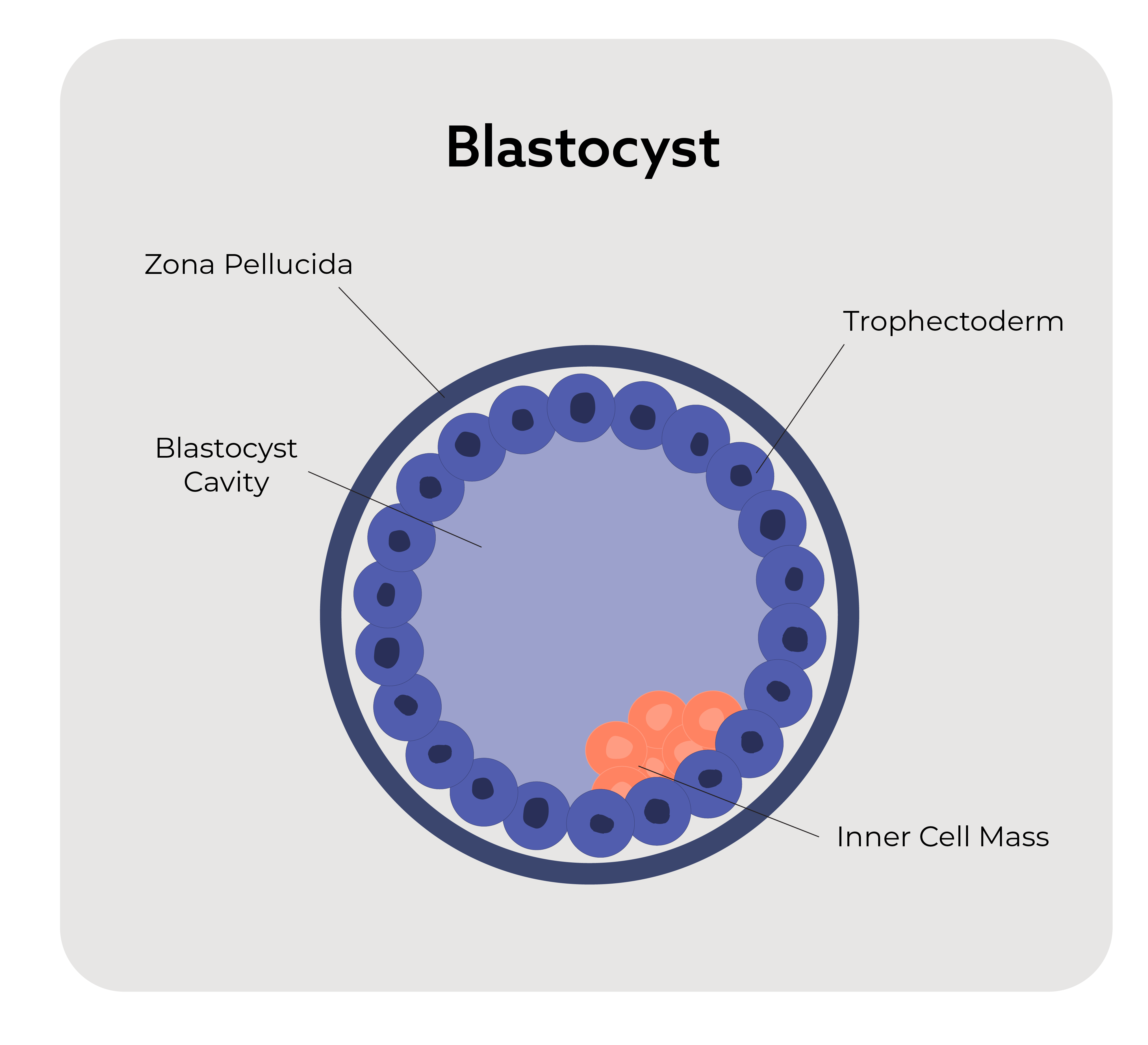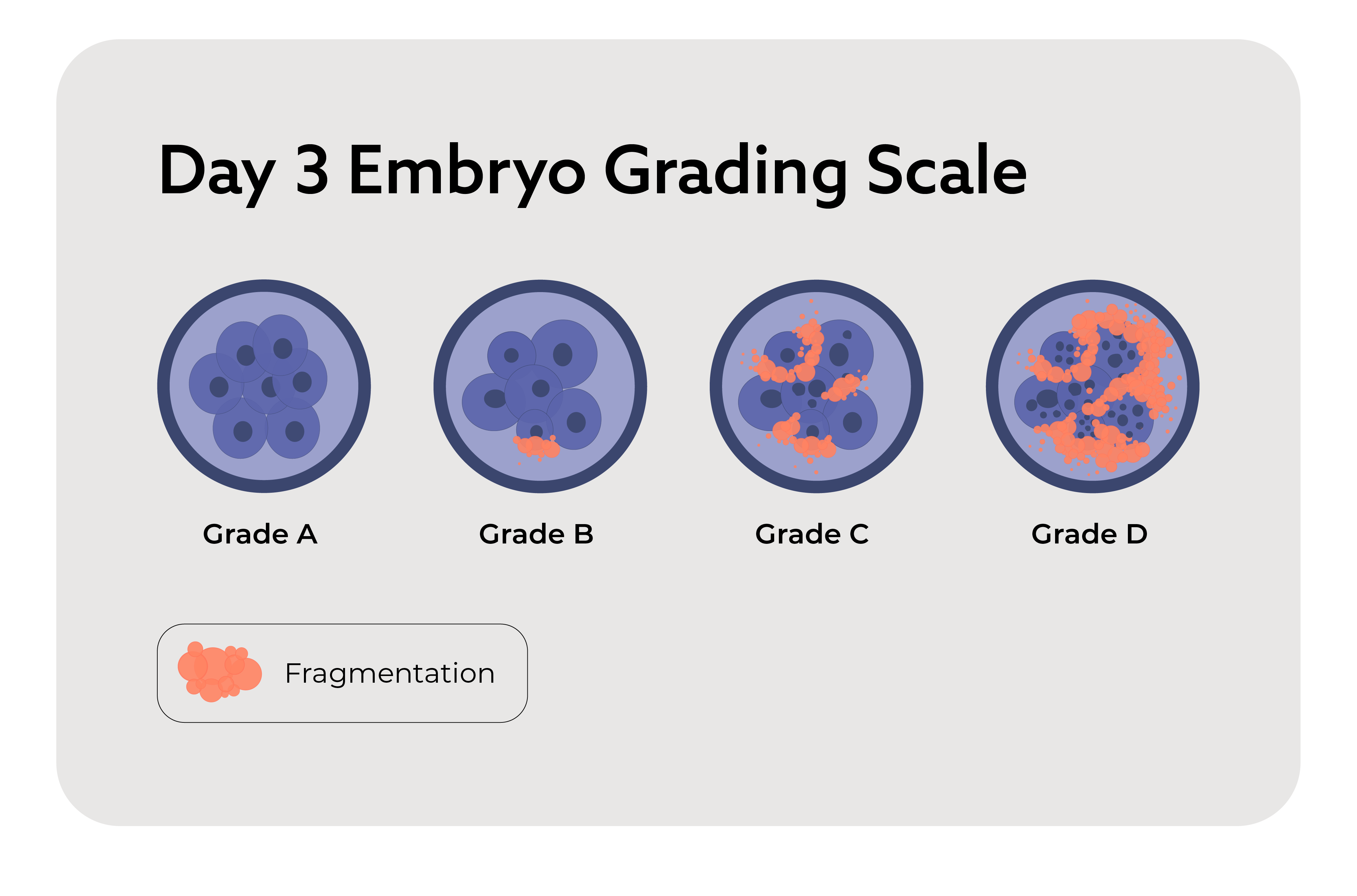Embryo grading is an evaluation process that embryologists use to assess the quality of embryos created through in vitro fertilization (IVF). To explain embryo grading more simply, it’s a way of determining which embryos have the highest chance of leading to a successful pregnancy.
Knowing which embryos are of good quality can result in a successful IVF cycle. If you’re considering surrogacy, beginning the process with graded embryos can also speed up your match time. In this article, we’ll explain how embryo grading is done, what the embryo grading scale means and why this process matters.
Do you already have your embryo grading results or expect to receive them soon? To learn more about the likelihood of implantation based on your results, check out our article about IVF success rates.
How Does Embryo Grading Work?
The grading process typically involves evaluating embryos at two key stages: the cleavage stage on day 3 and the blastocyst stage on day 5. While there is no universal system for grading embryos, most embryologists focus on specific characteristics at each stage.
During the grading process, they look at things like the shape and number of cells in the embryo. The best-graded embryos are usually chosen first for implantation to give the highest chance of success. Many surrogates are interested in working with intended parents who have graded embryos for this reason.
Day 3: Cleavage Stage Embryo Grading
At the cleavage stage, the embryo’s cells divide without increasing in size. Specialists generally look for six to 10 symmetrical cells within an outer shell called the zona pellucida. They don’t want to see fragmentation, which is the uneven division of cells resulting in tiny “loose” structures. Depending on the clinic you work with, specialists will grade the quality of the cells on a scale from 1 to 4 or A to D, with 1 or A being the highest quality and 4 or D being the lowest quality.
Day 5: Blastocyst Stage Embryo Grading
The blastocyst stage is a significant period in the embryo’s development. At this point, it is at an advanced stage of development, indicating the embryo is more viable and has a higher potential for implantation than a day 3 embryo.
By the fifth day, there could be over 150 cells composing two different parts of the embryo: the inner cell mass (ICM) and the trophectoderm (TE). The inner cell mass is the part that becomes the fetus, and the trophectoderm makes the placenta. The trophectoderm surrounds a fluid-filled blastocyst cavity that contains the inner cell mass.

On day 5, embryologists want to see an expanded blastocyst cavity, a compact inner cell mass and a large number of cells forming the trophectoderm. In addition to grading both layers of cells on a scale from A to C, they grade the blastocyst cavity’s expansion from 1 to 6, with 6 being the greatest level of expansion. Generally, a grade 5 level of expansion is the most ideal because it’s ready for implantation.
How to Read Embryo Grading Scales
Once you know what the typical scale looks like for the grading of embryos, you can better understand why certain ones are selected for the surrogacy process. Here’s how to read an embryo’s grade at each stage:
Day 3 Embryo Grading Scale: Cleavage Stage
Day 3 embryo grading evaluates the formation and number of cells. As such, embryologists only assign one number or letter grade to each cleavage-stage embryo.
Cells are uniform with no fragmentation Cells are mostly uniform with minor fragmentation Cells are unequal with zero to moderate fragmentation Cells are uniform or unequal with moderate to heavy fragmentation

Day 5 Embryo Grading Scale: Blastocyst Stage
The embryo grading system is more complex on day 5. At this point, embryologists assess the blastocyst cavity’s expansion and the quality of two groups of cells. They will provide a number and two letters to indicate how likely an embryo is to result in a successful transfer, such as 5AA (the most likely) or 1CC (the least likely).
Here’s what the blastocyst cavity looks like according to each number grade:
Blastocyst cavity is a third of the volume of the embryo Cavity is about half the volume of the embryo Cavity takes up most of the embryo Blastocyst cavity is fully expanded Blastocyst cavity is expanded and has split the outer shell Embryo has completely hatched
The inner cell mass is defined according to the first letter in the grade:
Many tightly packed cells Cells are loosely grouped Few large cells
Finally, the last letter reveals how developed the trophectoderm is:
Cells form a cohesive layer Cells stay loosely together Few cells in a poorly-formed layer
How Accurate Is Embryo Grading?
According to research, blastocyst cavity, inner cell mass and trophectoderm grades can significantly impact success. The study arranged day 5 embryos into four different groups: excellent, good, average and poor. Here’s what it discovered about each group’s clinical pregnancy rates:
-
Excellent: 65%
-
Good: 59.3%
-
Average: 50.3%
-
Poor: 33.3%
As you can see, there’s a significant drop in success rates between “average” and “poor” embryos and an even greater difference between “excellent” and “poor” embryos. There’s a higher chance of a successful transfer if you use embryos with higher grades.
However, it’s important to remember that embryo grading is not an absolute predictor of success. Other factors, such as the uterine environment and the transfer itself, play crucial roles in implantation success.
Does Embryo Grading Matter for Surrogacy?
Failed implantations can be disheartening and costly, highlighting how important embryo grading is in surrogacy. Depending on the surrogate’s health and the specific circumstances of the failed transfer, the doctor may recommend waiting one to three menstrual cycles before trying again. You will also need to pay for a second embryo transfer and compensate the surrogate.
Embryo grading doesn’t guarantee success; low-grade embryos can still result in successful pregnancies. However, high-grade embryos can increase the chances of implantation.
As hopeful parent, you probably want to grow your family as soon as possible. Understanding embryo grading and moving forward with the highest-graded embryos can get you one step closer to fulfilling your dream of parenthood.
If you’re not sure which would be the best day to transfer your graded embryo, you can learn more about day-by-day success rates. If you’re considering surrogacy, you can contact us online or call 1-800-875-BABY for more information about embryo grading with surrogacy. If you have embryos created, we can even help you find a surrogate.